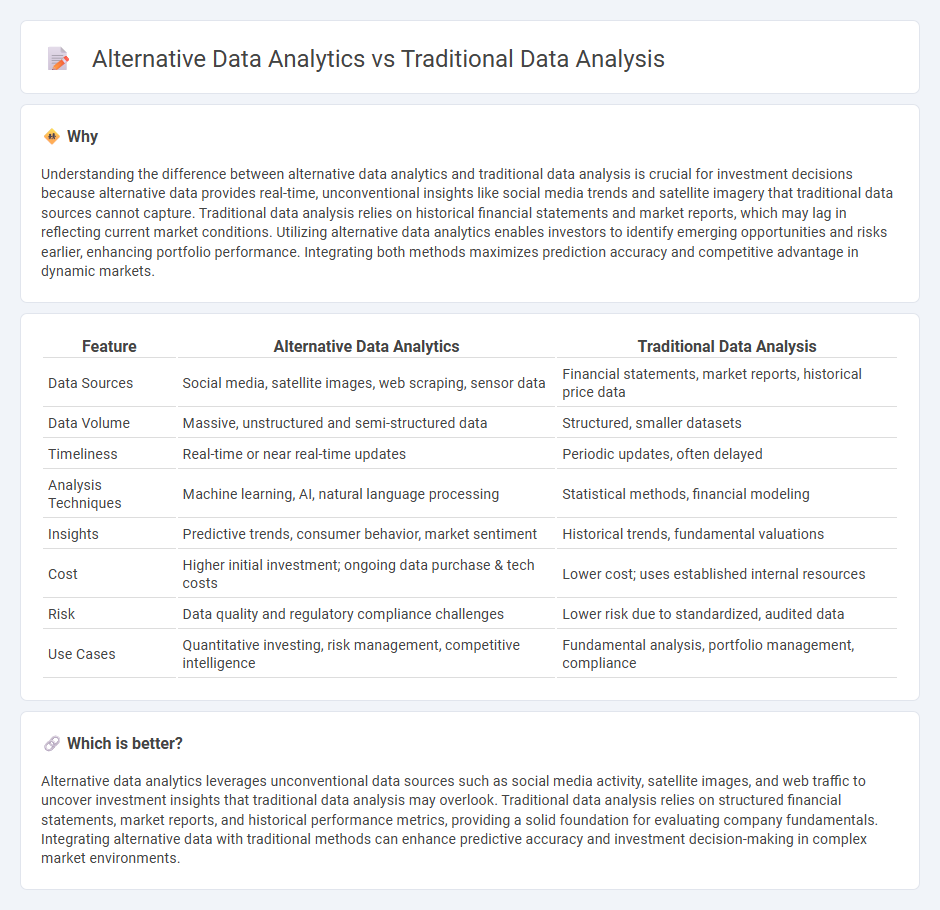
Alternative data analytics leverages unconventional sources such as social media trends, satellite images, and sensor data to uncover investment insights beyond traditional financial metrics. Traditional data analysis relies on structured financial statements, historical prices, and market reports to guide investment decisions. Explore how integrating alternative data can enhance portfolio performance and risk assessment.
Why it is important
Understanding the difference between alternative data analytics and traditional data analysis is crucial for investment decisions because alternative data provides real-time, unconventional insights like social media trends and satellite imagery that traditional data sources cannot capture. Traditional data analysis relies on historical financial statements and market reports, which may lag in reflecting current market conditions. Utilizing alternative data analytics enables investors to identify emerging opportunities and risks earlier, enhancing portfolio performance. Integrating both methods maximizes prediction accuracy and competitive advantage in dynamic markets.
Comparison Table
| Feature | Alternative Data Analytics | Traditional Data Analysis |
|---|---|---|
| Data Sources | Social media, satellite images, web scraping, sensor data | Financial statements, market reports, historical price data |
| Data Volume | Massive, unstructured and semi-structured data | Structured, smaller datasets |
| Timeliness | Real-time or near real-time updates | Periodic updates, often delayed |
| Analysis Techniques | Machine learning, AI, natural language processing | Statistical methods, financial modeling |
| Insights | Predictive trends, consumer behavior, market sentiment | Historical trends, fundamental valuations |
| Cost | Higher initial investment; ongoing data purchase & tech costs | Lower cost; uses established internal resources |
| Risk | Data quality and regulatory compliance challenges | Lower risk due to standardized, audited data |
| Use Cases | Quantitative investing, risk management, competitive intelligence | Fundamental analysis, portfolio management, compliance |
Which is better?
Alternative data analytics leverages unconventional data sources such as social media activity, satellite images, and web traffic to uncover investment insights that traditional data analysis may overlook. Traditional data analysis relies on structured financial statements, market reports, and historical performance metrics, providing a solid foundation for evaluating company fundamentals. Integrating alternative data with traditional methods can enhance predictive accuracy and investment decision-making in complex market environments.
Connection
Alternative data analytics complements traditional data analysis by incorporating unconventional data sources such as social media sentiment, satellite imagery, and transaction data to enhance investment decision-making. Integrating these diverse datasets allows investors to uncover hidden patterns, improve market predictions, and achieve a more comprehensive risk assessment. This synergy between alternative and traditional data analytics drives more informed investment strategies and competitive advantages.
Key Terms
Fundamental Analysis
Traditional data analysis in fundamental analysis relies on historical financial statements, earnings reports, and macroeconomic indicators to evaluate a company's intrinsic value. Alternative data analytics goes beyond by incorporating unconventional data sources such as social media sentiment, satellite imagery, and web traffic patterns to uncover hidden market trends. Explore how combining these methods can enhance investment decision-making and provide a competitive edge.
Sentiment Analysis
Traditional data analysis primarily relies on structured datasets like sales figures and demographic information, enabling quantitative insights through statistical methods. Alternative data analytics, especially in sentiment analysis, leverages unstructured sources such as social media posts, reviews, and news articles to gauge public opinion and market moods in real time. Explore the latest techniques and tools in sentiment analysis to enhance decision-making and competitive advantage.
Machine Learning
Traditional data analysis relies on structured datasets and statistical methods to identify patterns, while alternative data analytics employs diverse unstructured data sources such as social media, satellite imagery, and sensor data, leveraging machine learning algorithms for deeper insights. Machine learning enhances alternative data analytics by enabling predictive modeling, anomaly detection, and real-time data processing across large, complex datasets. Explore how integrating machine learning with alternative data sources revolutionizes decision-making and forecasting accuracy.
Source and External Links
AI-Powered Analytics vs. Traditional Data Analysis - Infomineo - Traditional data analysis uses statistical methods and human expertise to examine data by summarizing features, exploratory data analysis, hypothesis testing, regression, and time series analysis without advanced AI or machine learning involvement.
Generative analysis vs. traditional data analysis - Monterey AI - Traditional data analysis typically involves humans analyzing quantitative datasets using tools like Tableau, Excel, and Looker based on pre-determined metrics to derive insights and make predictions.
Difference Between Traditional Data and Big Data - GeeksforGeeks - Traditional data analysis relies on structured, well-organized data managed by SQL-based systems using statistical methods and visualizations to identify trends and patterns, but is limited in handling unstructured or very large datasets.
 dowidth.com
dowidth.com